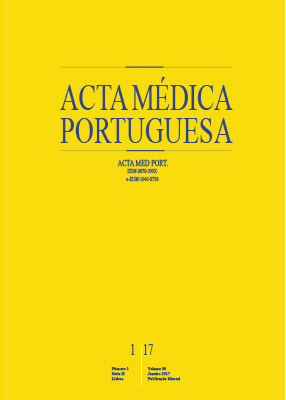Perinatal Outcome in Relation to Chorionicity in Twin Pregnancy
DOI:
https://doi.org/10.20344/amp.7133Keywords:
Chorion, Pregnancy Complications, Pregnancy Outcome, Pregnancy, TwinAbstract
Introduction: The incidence of multiple gestations is increasing worldwide and many studies have shown higher perinatal morbidity and mortality rates in monochorionic twins compared to dichorionic. The aim of this study was to assess the twin population born at a tertiary center and to evaluate the impact of chorionicity on perinatal outcomes of twin pregnancies.
Material and Methods: Retrospective study of all twins born in a tertiary center from January 2004 to December 2013.
Results: In this period, 1051 twins were born, related to 540 gestations (26.7% monochorionic; 73.3% dichorionic). There was no statistical significant difference between the groups concerning obstetric complications. The monochorionic group had a higher incidence of intrauterine growth restriction (20.5 vs 11.3%, p < 0.001), lower mean maternal age (29.9 vs 31.9 years, p < 0.001), lower mean gestational age (33.4 vs 34.3 weeks, p < 0.05) and lower mean birth weight (1943 vs 2147 g, p < 0.001). Monochorionic twins had a higher incidence of hyaline membrane disease (7 vs 4%, p < 0.05), sepsis (10.3 vs 5.8%, p < 0.05) and anemia (9.5 vs 5.4%, p < 0.05). There were no statistical significant differences concerning necrotizing enterocolitis, intraperiventricular hemorrhage or retinopathy of prematurity. Perinatal mortality was higher in the monochorionic group (5.2 vs 2.9%, p < 0.05).
Discussion: Monochorionic twins represent considerable challenges to both obstetricians and neonatologists and should be monitored and delivered at tertiary centers.
Conclusion: Currently gemelarity has a major impact on total births. It would be interesting to develop protocols to standardize clinical approach to twins.
Downloads
Downloads
Published
How to Cite
Issue
Section
License
All the articles published in the AMP are open access and comply with the requirements of funding agencies or academic institutions. The AMP is governed by the terms of the Creative Commons ‘Attribution – Non-Commercial Use - (CC-BY-NC)’ license, regarding the use by third parties.
It is the author’s responsibility to obtain approval for the reproduction of figures, tables, etc. from other publications.
Upon acceptance of an article for publication, the authors will be asked to complete the ICMJE “Copyright Liability and Copyright Sharing Statement “(http://www.actamedicaportuguesa.com/info/AMP-NormasPublicacao.pdf) and the “Declaration of Potential Conflicts of Interest” (http:// www.icmje.org/conflicts-of-interest). An e-mail will be sent to the corresponding author to acknowledge receipt of the manuscript.
After publication, the authors are authorised to make their articles available in repositories of their institutions of origin, as long as they always mention where they were published and according to the Creative Commons license.









